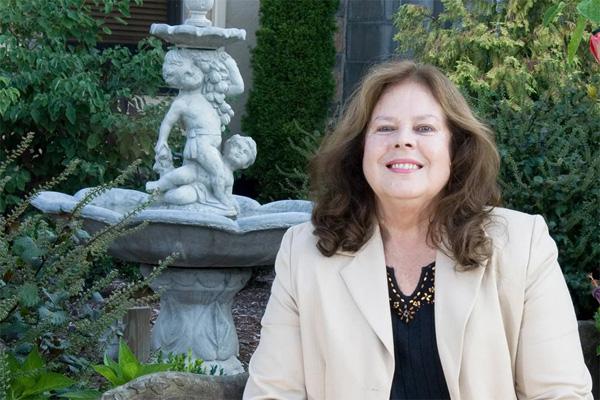
New Humanities in the Park display traces Native Americans' contributions to Ohio

A new display in Richland Avenue Park in Athens traces Indigenous Americans’ material and cultural contributions to Ohio, from their early creation of large earthworks to modern representations and reflections on the past.
This exhibit, Ohio’s First Humanists: Native Americans from Mound Building to Modern Voices, is the third installment in the Humanities in the Park collaboration between Ohio University's Charles J. Ping Institute for the Teaching of the Humanities in the College of Arts and Sciences, the Athens Department of Arts, Parks and Recreation, and the Athens County Public Libraries.
"Ohio was once home to 40 tribes, and it remains the traditional home of the Shawnee peoples," said Fred Drogula, the Charles J. Ping Professor of Humanities in the College of Arts and Sciences and director of the Ping Institute.

The exhibit is aptly timed in 2023, a year that could see the Hopewell Ceremonial Earthworks in Ohio achieve World Heritage status, a project long-advocated by Eastern Shawnee Nation Chief Glenna Wallace, who spoke about her people's heritage in a 2020 conference at OHIO on Settling Ohio: First Nations and Beyond. (See her passionate address on YouTube.)
Wallace's ancestors were forced to leave their Ohio Valley home for reservations in Oklahoma and Kansas, and she currently resides in Missouri — but in speaking about the relationship between the Shawnee and Ohio, Wallace said, “We are still here in a certain way. We are here in our hearts.”
The first settlers to Ohio arrived more than 13,000 years ago. They likely traveled a land bridge from Asia down through Western North America, then made their way east to the Ohio Valley. The Southeastern Ohio region was at one time a convergence zone of some 40 tribes, including the Mingo, Erie, Lenape, Wyandot, and Miami people, as well as others that shared in the rich hunting grounds and relative safety that these lands provided. It became the traditional homelands of the Shawnee peoples as well as the Wahzhazhe (Osage) nations.
The name “Ohio'' comes from a Seneca (Iroquois) word, which means “good” or “great river.”
"In preparing this exhibit, we sought to not only acknowledge the past cultures and complex histories of this area, but also to elevate the voices of Native American peoples, past and present,” said Brian Schoen, the James Richard Hamilton/Baker and Hostetler Professor of Humanities in the College of Arts and Sciences at OHIO. Ohio State University Professor John Low, a member of the Pokogan Band of Potawatomi Indians who also serves as Director of Newark Earthworks Center, consulted on the project.
In 1795, after at least a decade of war with the United States, leaders from a dozen sovereign nations were forced to sign the Treaty of Greenville, which ceded lands comprising most of eastern, southern, and central Ohio to the U.S. government. A confederacy of tribes, united under the great Shawnee leader Tecumseh, continued to resist U.S. aggression until 1815, when they were eventually forced from Ohio, including lands currently occupied by Athens, Ohio University, and this exhibit. Many Shawnee, meanwhile, remained on reservation land in Ohio until 1831, when they were finally compelled to emigrate to Native American Territories west of the Mississippi River. The final Ohio tribe to be removed was the Wyandot in 1843.
"Nevertheless, more than 200 years later, people from a broad array of Indigenous cultures continue to call this land home and have contributed significantly to the local, national, and international study of humanities. This exhibit recognizes the important contributions of some of those people," Schoena said.
The exhibit, also available on the Ping Institute website, is designed to help visitors:
- Learn about First Nations’ roles in shaping place names and get interpretive glimpses into early Ohio’s history of Native American-white contact, which included collaboration, conflict, and removal.
- Explore present-day stewardship of Native American culture and art, including the impressive collection of Diné (Navajo) weavings at the Kennedy Museum of Art, as well as the voices of innovative communicators looking to change perceptions about Native American peoples and powerful leaders, such as Glenna Wallace, the Chief of the Eastern Shawnee nation, whose ancestors were displaced from these lands.
- Discover the value of moving beyond traditional Eurocentric understandings of the humanities to explore the first humans to inhabit this region and North America more broadly.
About Humanities in the Park
This exhibit is the third installment in the Humanities in the Park collaboration between the Ohio University Charles J. Ping Institute for the Teaching of the Humanities in the College of Arts and Sciences, the Athens Department of Arts, Parks and Recreation, and the Athens County Public Libraries. The project is made possible, in part, by a grant from Ohio Humanities, a state affiliate of the National Endowment for the Humanities.
Previous installations, which also can be viewed online, include:
The Ohio University Libraries, in particular the Mahn Center for Archives and Special Collections and the Digital Initiatives Department, also are substantial contributors to this effort to highlight the humanities.
